Act 1 – 4: Film Program
Silver Screen Resistance
All exhibition venues
March 24 – July 9, 2006
Each film in the program is screened once a week at each exhibition venue
The film program Silver Screen Resistance reflects four decades of postcolonial cinema with the newest film being made especially for Rethinking Nordic Colonialism. Featuring prominent examples of resistance in cinema, the program introduces critical notions of postcolonial opposition and documents specific local battles against the tyranny of Western modernization.
FILM PROGRAM PARTICIPANTS
Stephanie Black (USA)
Randi Broberg in collaboration with Tine Bryld (Greenland/Denmark & Denmark)
Laila Hansen (Greenland)
Isaac Julien (United Kingdom)
Alanis Obomsawin (Abenaki, Canada)
Pratibha Parmar (Kenya/United Kingdom)
Gillo Pontecorvo (Italy)
Paul-Anders Simma (Sámi, Norway/Sweden/Finland)
Act 1: Screening Hours, The Living Art Museum, Reykjavik
March 24 – April 16, 2006
Wednesdays, 3 pm:
Gillo Pontecorvo
“The Battle of Algiers,” 1966
DVD NTSC, 121 min. (English subtitles)
Thursdays, 3 pm:
Alanis Obomsawin
“Is the Crown at war with us?,” 2002
DVD, 96:31 min. (English language)
Fridays, 3 pm:
Stephanie Black
“Life and Debt,” 2001
DVD, 86 min. (English language)
Saturdays, 2 pm:
Randi Broberg in collaboration with Tine Bryld
“With the Best of Intentions: Interview with Tine Bryld,” 2006
DVD, 30 min. (English subtitles)
Isaac Julien
“Looking for Langston,” 1989
DVD, 40 min. (English language)
Paul-Anders Simma
“Give Us Our Skeletons!,” 1999
DVD, 49 min. (English subtitles)
Sundays, 2 pm:
Laila Hansen
“Inuk Woman City Blues,” 2002
DVD, 35 min. (English subtitles)
Pratibha Parmar
“A Place of Rage,” 1991
DVD, 54 min. (English language)
Laugavegi 26, 101 Reykjavik
Admission free
Act 2: Screening Hours,
Greenland National Museum and Archives, Nuuk
April 21 – May 14, 2006
Tuesdays, 2 pm:
Gillo Pontecorvo
“The Battle of Algiers,” 1966
DVD NTSC, 121 min. (English subtitles)
Wednesdays, 2 pm:
Alanis Obomsawin
“Is the Crown at war with us?,” 2002
DVD, 96:31 min. (English language)
Thursdays, 2 pm:
Stephanie Black
“Life and Debt,” 2001
DVD, 86 min. (English language)
Fridays, 2 pm:
Randi Broberg in collaboration with Tine Bryld
“With the Best of Intentions: Interview with Tine Bryld,” 2006
DVD, 30 min. (English subtitles)
Isaac Julien
“Looking for Langston,” 1989
DVD, 40 min. (English language)
Saturdays, 2 pm:
Paul-Anders Simma
“Give Us Our Skeletons!,” 1999
DVD, 49 min. (English subtitles)
Laila Hansen
“Inuk Woman City Blues,” 2002
DVD, 35 min. (English subtitles)
Sundays, 2 pm:
Pratibha Parmar
“A Place of Rage,” 1991
DVD, 54 min. (English language)
Hans Egedevej 8, 3900 Nuuk
Admission free
Act 3: Screening Hours, The Faroe Islands Art Museum, Tórshavn
May 12 – June 4, 2006
Tuesdays, 2 pm:
Gillo Pontecorvo
“The Battle of Algiers,” 1966
DVD NTSC, 121 min. (English subtitles)
Wednesdays, 2 pm:
Alanis Obomsawin
“Is the Crown at war with us?,” 2002
DVD, 96:31 min. (English language)
Thursdays, 2 pm:
Stephanie Black
“Life and Debt,” 2001
DVD, 86 min. (English language)
Fridays, 2 pm:
Randi Broberg in collaboration with Tine Bryld
“With the Best of Intentions: Interview with Tine Bryld,” 2006
DVD, 30 min. (English subtitles)
Isaac Julien
“Looking for Langston,” 1989
DVD, 40 min. (English language)
Saturdays, 2 pm:
Pratibha Parmar
“A Place of Rage,” 1991
DVD, 54 min. (English language)
Sundays, 2 pm:
Laila Hansen
“Inuk Woman City Blues,” 2002
DVD, 35 min. (English subtitles)
Paul-Anders Simma
“Give Us Our Skeletons!,” 1999
DVD, 49 min. (English subtitles)
Gundadalsvegur 9, 110 Tórshavn
Admission: adults DKK 60, children under 12 years and school classes free,
pensioners/students/groups of ten DKK 40
(includes entrance to exhibitions)
Act 4: Screening Hours, VR:n Veturitalli
(Finnish Railways Locomotive Engine Shed), Rovaniemi
June 16 – July 9, 2006
Wednesdays, 3 pm:
Gillo Pontecorvo
“The Battle of Algiers,” 1966
DVD NTSC, 121 min. (English subtitles)
Thursdays, 3 pm:
Alanis Obomsawin
“Is the Crown at war with us?,” 2002
DVD, 96:31 min. (English language)
Fridays, 3 pm:
Stephanie Black
“Life and Debt,” 2001
DVD, 86 min. (English language)
Saturdays, 2 pm:
Randi Broberg in collaboration with Tine Bryld
“With the Best of Intentions: Interview with Tine Bryld,” 2006
DVD, 30 min. (English subtitles)
Isaac Julien
“Looking for Langston,” 1989
DVD, 40 min. (English language)
Paul-Anders Simma
“Give Us Our Skeletons!,” 1999
DVD, 49 min. (English subtitles)
Sundays, 2 pm:
Laila Hansen
“Inuk Woman City Blues,” 2002
DVD, 35 min. (English subtitles)
Pratibha Parmar
“A Place of Rage,” 1991
DVD, 54 min. (English language)
Rovaniemen asema-alue, 96100 Rovaniemi
Admission free
STEPHANIE BLACK
Born 1961 in Brooklyn, New York, USA. Lives and works in New York.
Stephanie Black is a producer and director. Filmography includes the award-winning feature-length documentaries “Life and Debt” (2001) and “H-2 Worker” (1990), which won both Best Documentary and Best Cinematography at the Sundance Film Festival in 1990. Upon completion of “H-2 Worker,” Stephanie Black was hired as the Chief Researcher and Second Unit Director of “Incident at Oglala,” an award-winning featurelength documentary on Leonard Peltier and the activities of the FBI on the Pine Ridge Reservation during the 1970s. For over ten years, Stephanie Black has been producing and directing live-action documentary segments for American children's television. She also produced and directed a Public Service Announcement on the problem of lack of equal economic opportunity in USA entitled “More Than Luck” for Direct Impact, a nonprofit organization in Athens, Georgia. Stephanie Black has also produced and directed music videos and Eletronic Press Kits for such artists as Ziggy Marley and the Melody Makers, Buju Banton, Snow, Anthony B, INOJ, among others. In 1999, Stephanie Black directed and produced a 30-minute documentary on the “Making of Chant Down Babylon”, a Bob Marley tribute album produced by Stephen Marley featuring Lauryn Hill, Busta Rhymes, and Erykah Badu, among others. Other related work experience includes Adjunct Professor of Documentary Film at the School of Visual Arts, New York (1991-94) and presently instructor of documentary workshops at Y/FVA in New York. [www.lifeanddebt.org]
Stephanie Black participates with her film “Life and Debt” from 2001. The film is set in “…Jamaica – land of sea, sand, and sun. And a prime example of the complexities of economic globalization on the world's developing countries. Using conventional and non-conventional documentary techniques, this searing film dissects the ‘mechanism of debt’ that is destroying local agriculture and industry in Third World countries while substituting them with sweatshops and cheap imports. With a voice-over narration written by Jamaica Kincaid, adapted from her non-fiction book A Small Place (1988), ‘Life and Debt’ is an unapologetic look at the ‘new world order’ from the point of view of Jamaican workers, farmers, government and policy officials, who see the reality of globalization from the ground up. The documentary film includes interviews with Former Prime Minister Michael Manley, Deputy Director of the International Monetary Fund Stanley Fischer, and short commentary by President of Haiti-Jean-Bertrand Aristide and Former President of Ghana Jerry Rawlings. But the articulate voices of those impacted by the policies of globalization are foremost.” [www.newyorkerfilms.org]
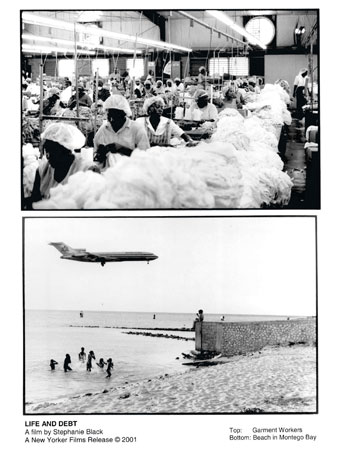
Stephanie Black, Stills from “Life and Debt,” 2001.
Feature film, 86 min. Courtesy of the artist.
RANDI BROBERG in collaboration with TINE BRYLD
Born 1978 in Qeqertarsuaq, Greenland. Lives and works in Copenhagen, Denmark.
Born 1939 in Denmark. Lives and works in Copenhagen, Denmark.
Randi Broberg has recently enrolled at the National Film School of Denmark, Copenhagen in the documentary film director department. After attending primary school, she went to a continuation school in Roskilde, Denmark (1994) to graduate from Aasiaat High School in Greenland in 1999. She holds a BA in Culture and Social History from the University of Greenland, Nuuk (2003) and has attended The European Film College in Ebeltoft, Denmark (2004). Since 2003, she has been working as freelancer for KNR, Greenland National Broadcasting Company, producing cultural programs for television. She has also been involved in film productions and has produced radio shows on cultural issues. In addition, Broberg is co-founding member of the youth movement, Inuit Youth International, (2001) and has organized and participated in various cultural activities, debates, and demonstrations. She has lectured at various conferences, has been a member of various boards, and coordinated the youth festival Saqqaq Midnight Festival in 2005. Broberg also writes poetry, short stories, and plays in addition to composing music, singing, and acting (mask dancing). [Randi Broberg]
Tine Bryld is a writer and a hostess for a youth program on DR (Danish Broadcasting Corporation), advising youth about life affairs. She has written novels and documentaries about different subjects, but the books she is most devoted to are her books on the relation between Greenland and Denmark during the last 50 years – after colonialism. She has written two books on Greenlandic criminal law; a system which rests on re-socialization rather than punishment. Both deal with the incarceration of Greenlandic criminals in closed Danish prisons, where they remain for years and years on the grounds that ‘they are not to be punished but treated’!! Bryld’s third book on Greenland, I den bedste mening (With the Best of Intentions), tells the story of 22 Greenlandic children, who in 1951 were removed from their homes and sent to Denmark. Bryld’s latest book on Greenland, Hjemmestyrets børn, årgang 79 (Children of the Home Rule, Year 79), documents the generation of young people born in 1979 when Greenland got home rule. All her books are translated into Greenlandic. Bryld has also been working as an advisor for the Danish Government in the free city, Christiania, in Copenhagen where a large number of Greenlandic people live, lost to both Denmark and Greenland. [Tine Bryld]
In the video “With the Best of Intentions: Interview with Tine Bryld” from 2006, Randi Broberg interviews Tine Bryld about her book I den bedste mening (With the Best of Intentions). The video is made especially for Rethinking Nordic Colonialism and could be characterized as a screen version of the book, which tells “…the story of 22 Greenlandic children, who in 1951 were chosen from all parts of Greenland to come to Denmark and live with foster families. The children were chosen among lower class families and had to be intelligent. After one and a half year with the Danish foste families, they were sent back to Greenland in 1952 and moved into Danish Red Cross’ newly built children’s home in Nuuk. They spoke Danish and were taught in Danish. Trine Bryld has traced the children and their families today. Why did this happen and how have they managed since then?” (Back cover text from Tine Bryld, I den bedste mening, Nuuk: Atuakkiorfi, 1998]
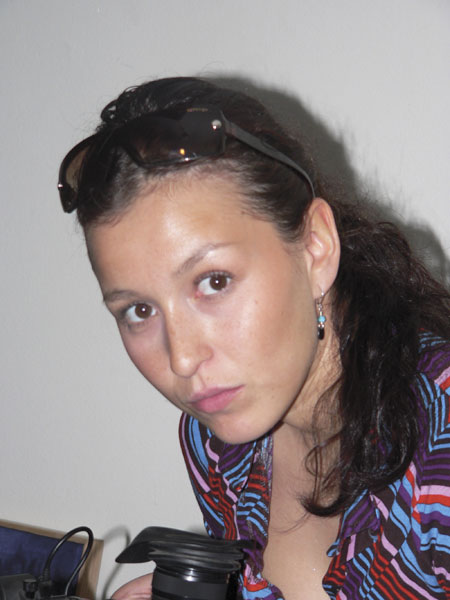
Randi Broberg, 2005. Courtesy of the artist.
LAILA HANSEN
Born 1966 in Qaqortoq, Greenland. Lives and works in Qaqortoq.
Laila Hansen is a filmmaker and actress from Greenland. She has worked and is still working with Canadian Aboriginals, Danish producers, and Inuit filmmakers. Recently, Hansen was the lead actress in the Canadian film “Kiviuq” (premiere October, 2006). She is presently fundraising for an Inuit fiction feature, editing the documentary film “Portrait of Inuit Theatre,” and is on pre-production on the docufiction “Inuit Spirit.” [Laila Hansen]
Laila Hansen participates with her film “Inuk Woman City Blues” from 2002, a film about and with Inuit women in a Copenhagen drinker’s district. “In downtown Copenhagen in the Vesterbro district many women who have arrived from Greenland end up in a miserable situation, homeless and drinking heavily. Many only survive for a few years. And almost no one ever returns to Greenland. The film follows a group of women who are ready to talk openly about their personal backgrounds, why they left Greenland, why they ended up as drunkards and how they survive today. One strong person, Rosine Berthels, recently stopped drinking after 25 years and now spends her time as a social worker, helping the drinkers to come out of their alcoholism. In the end of the film, she tells about her approaching return to Greenland.
The film is not a traditional social documentary. It is created by the actress, singer and dancer Laila Hansen, herself a native of Greenland, and thus it has become a musically poetic narration, filled with love and tenderness for the women who appear in the film, so we end up really liking them. They are a group of women with an inner core of survival energy, defying their miserable life situation. The language of the film being Greenlandic and the structure of the story with songs and lyrics so typical of Greenland matched with modern digitized music creates an experience totally different from what we are used to from television.” [www.vestfilm.dk]
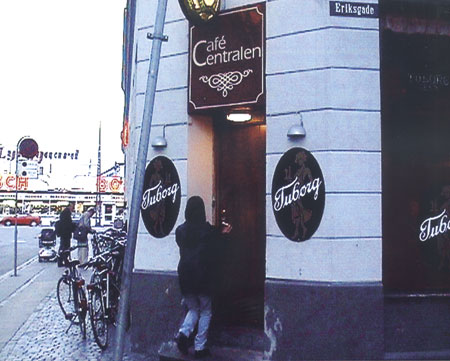
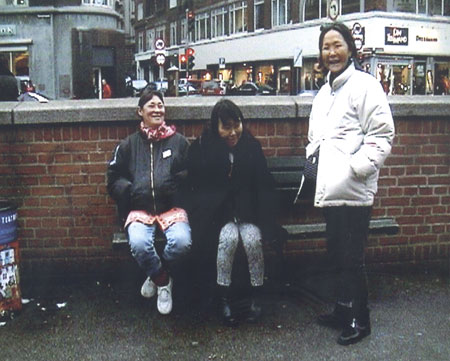
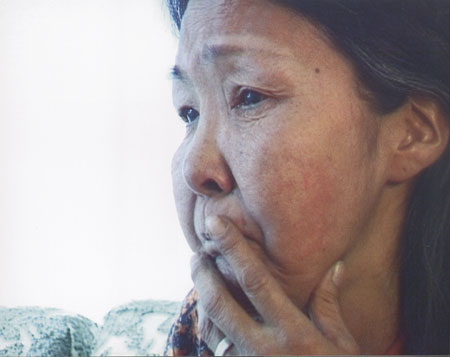
Laila Hansen, Stills from “Inuk Woman City Blues,” 2002.
DVD, 35 min. Courtesy of Nils Vest Film, Copenhagen.
ISAAC JULIEN
Born 1960 in London, United Kingdom. Lives and works in London.
Isaac Julien graduated from St. Martin’s School of Art, United Kingdom, where he studied painting and fine art film. Exhibitions in 2005 include: Centre Georges Pompidou (Paris), MAK Center (Los Angeles), Irish Museum of Modern Art (Dublin), Museum of Contemporary Art (Miami), and Tate Modern (London). Julien’s audio visual film installations include: “Fantôme Afrique” (2005), “True North” (2004), “Baltimore” (2003), which won the Grand Jury Prize at the Kunst Film Biennale in Cologne, “Paradise Omeros” (2002), “Vagabondia” (2000), choreographed by Javier de Frutos, for which he was nominated for the 2001 Turner Prize, and “The Long Road to Mazatlan” (1999), made in collaboration with Javier de Frutos. Earlier films include: the Cannes prize-winning “Young Soul Rebels” (1991), “Looking for Langston” (1989), and “Frantz Fanon: Black Skin, White Mask” (1996). Julien won the prestigious MIT Eugene McDermott Award in the Arts, 2001 and the Aurora Award in 2005. Solo exhibitions have included: Kunstforeningen Gl. Strand (Copenhagen, Denmark), Musee d’art contemporain de Montreal, House of World Cultures (Berlin), Art Pace (San Antonio), and Bohen Foundation (New York). The Film Art of Isaac Julien, curated by Amada Cruz at the Center for Curatorial Studies Museum (Bard College, Annandale-on-Hudson, New York), was shown at the Museum of Contemporary Art Sydney and toured to the Bildmuseet Umeå (Sweden), Henie Onstad Museum (Norway), and Yerba Buena Center (San Francisco). Isaac Julien is currently visiting Mellon Professor at University of Pittsburgh and is a Trustee of the Serpentine Gallery and InIVA in London and of the Art Pace Foundation in San Antonio, Texas.
Isaac Julien participates with the film “Looking for Langston” from 1989. The private world of the black artists and writers, such as Langston Hughes, who formed the Harlem Renaissance of the 1920s, is recreated in a mythic dimension. The film switches from archive footage to a stylized version of the jazz and blues infected Harlem to explore questions of black beauty within queer desire. [Isaac Julien]
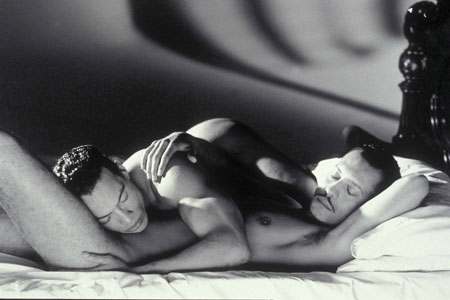
Isaac Julien, “Looking for Langston,” 1989.
DVD, 40 min. Photo: © Sunil Gupta. Courtesy of the artist.
ALANIS OBOMSAWIN
Born 1932 in New Hampshire, USA, on Abenaki Territory. Lives and works in Quebec, Montreal, Canada.
Alanis Obomsawin, a member of the Abenaki nation, is one of Canada’s most distinguished documentary filmmakers. Obomsawin began her career as a singer, writer, and storyteller, but dove into filmmaking in 1967 with “Christmas at Moose Factory,” which she wrote and directed. Since then, Obomsawin has made over 20 uncompromising documentaries on issues affecting Aboriginal people in Canada. The 2000 National Film Board (NFB) release “Rocks at Whiskey Trench” was Obomsawin’s fourth film in her series about the 1990 Oka crisis. The first, “Kanehsatake: 270 Years of Resistance” (1993), was a feature-length film documenting the 1990 Mohawk uprising in Kanehsatake and Oka, which has won 18 international awards. It was followed by “My Name is Kahentiiosta” (1995), a film about a young Kahnawake Mohawk woman who was arrested after the 78-day aqrmed standoff, and “Spudwrench – Kahnawake Man” (1997), profiling Randy Horne, a high-steel worker from the Mohawk community of Kahnawake. Her latest NFB production, “Our Nationhood” (2003), chronicles the determination and tenacity of the Listuguj Mi’gmaq people to use and manage the natural resources of their traditional lands. The Mi’gmaq of Esgenoopetitj (Burnt Church), New Brunswick, Canada were the subject of her 2002 documentary “Is the Crown at war with us?” (2002), a powerful and painstakingly researched look at the conflict over fishing rights. For 31 years, Obomsawin has directed documentaries at the NFB with strong social content, inspired by the desire to let the voices of her people be heard. In 1983, she was made a member of the Order of Canada, in recognition of her dedication to the well-being of her people and the preservation of the First Nations’ heritage through her filmmaking and activism. Obomsawin’s films also include: “Incident at Restigouche” (1984), a powerful depiction of the Quebec police raid of a Micmac reserve; “Richard Cardinal: Cry from a Diary of a Métis Child” (1986), the disturbing examination of an adolescent suicide; and “No Address” (1988), a look at Montreal’s homeless.
Alanis Obomsawin participates with her film “Is the Crown at war with us?” (2002). In the summer of 2000, Canada watched with disbelief as federal fishery officers appeared to wage war on the Mi’gmaq fishermen of Esgenoopetitj (Burnt Church), New Brunswick, Canada. Why would officials of the Canadian government attack citizens for exercising rights that had been affirmed by the highest court in the land? What happened at Burnt Church? Alanis Obomsawin casts her cinematic and intellectual nets into history to provide a context for the events on Miramichi Bay. Delineating the complex roots of the conflict with passion and clarity, she builds a persuasive defense of the Mi’gmaq position. With “Is the Crown at war with us?,” she offers compelling insight into the complex relationship between Canada and its First Nations. [National Film Board of Canada]
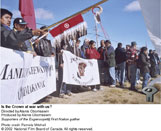
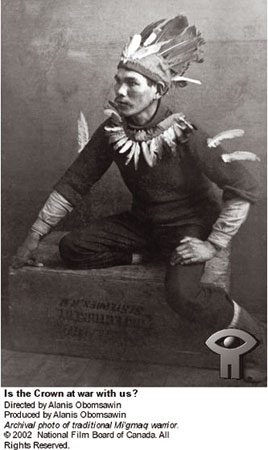
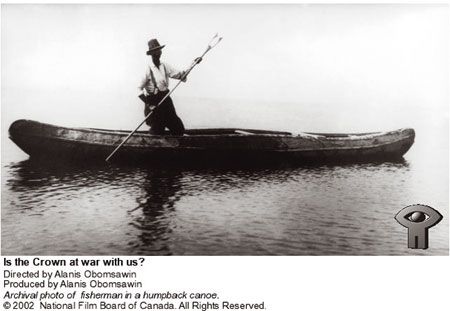
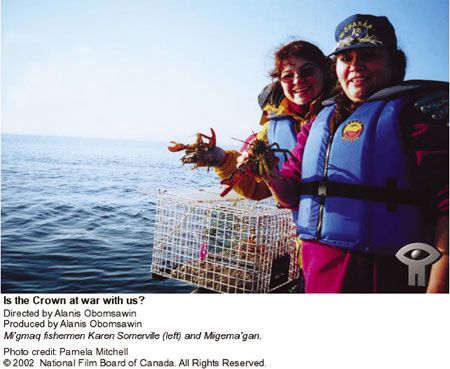
Alanis Obomsawin, Stills from “Is the Crown at war with us?” 2002.
DVD, 96:31 min. Courtesy of National Film Board of Canada.
PRATIBHA PARMAR
Born in Nairobi, Kenya. Lives and works in London, United Kingdom.
Pratibha Parmar was born in Nairobi, Kenya and came with her family to live in England in 1967. Before she began to make films, she was a youth and community worker working in the Asian community with young women. She studied at Bradford University for her BA Honors degree and did postgraduate studies at the Cultural Studies Centre at Birmingham University. In 1975, Parmar traveled to India and worked as volunteer in rural development projects around India. During this time, she spent 3 months working in Calcutta with Mother Teresa. In the mid-1980s, Parmar worked in the feminist publishing collective, Sheba Feminist Press, where she was responsible for editing and publishing writings by Asian and African Caribbean women, including the British publication of The Cancer Journals by Audre Lorde. She gave the Keynote address to the “OUTWRITE” conference in Boston in February 1999 and was invited to be a Regents Lecturer at the University of San Diego in spring 1999. Pratibha is a Board member of Women in Film and Television (UK) and of The Directors Guild of Great Britain.
Pratibha Parmar participates with her film “A Place of Rage” from 1991. This exuberant celebration of African American women and their achievements features interviews with Angela Davis, June Jordan, and Alice Walker. Within the context of the civil rights, Black power, and feminist movements, the trio reassess how women such as Rosa Parks and Fannie Lou Hamer revolutionized American society. Angela Davis, at one time the FBI’s most wanted woman, recounts her involvement with the Black Panthers and the communist party. Her rarely seen 1970 prison interview, civil rights footage, and archival photos are interwoven with June Jordan’s powerful poetry, linking issues of homophobia, racism, US imperialism, and liberation struggles worldwide. The insights of acclaimed writer Alice Walker (The Color Purple) and filmmaker Trinh T. Minh-ha enrich this engrossing portrait of African American feminism. A stirring chapter in African American history, highlighted by music from Prince, Janet Jackson, the Neville Brothers, and the Staple Singers. [Pratibha Parmar]
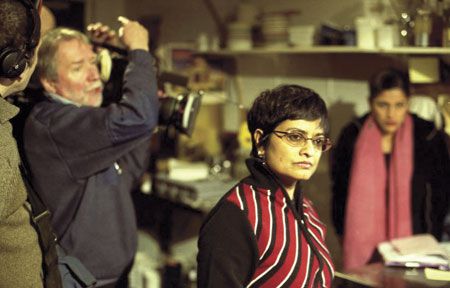
Pratibha Parmar on set.

Pratibha Parmar, Still from “A Place of Rage,” 1991.
DVD, 54 min. Courtesy of the artist.
GILLO PONTECORVO
Born 1919 in Pisa, Italy. Died 2006 in Rome, Italy.
Gillo Pontecorvo was born into an Italian-Jewish family of Pisa in 1919, the son of a factory owner who employed 1,500 workers. He was introduced to communism in the late 1930s by his older brother Bruno and his circle of anti-fascist friends. During World War II, while studying chemistry, Pontecorvo worked as a journalist and courier for the Italian Communist Party. He helped organize a network of anti-Fascist partisans and served as a leader of the Garibaldi Brigade, using the nom de guerre “Barnaba.” After the war, working as a journalist in Paris, he happened to see Rossellini’s “Paisan” and was so moved by the experience that he left his job, bought a camera, and began making documentary shorts. Pontecorvo’s narrative efforts began in 1956 with the short “Giovanna,” which he described as “a feminist film before there was feminism.” That same year came “The Wide Blue Road,” his first narrative feature adapted from a novel by Franco Solinas. This was followed in 1959 with “Kapo,” the story of a 14 year-old girl’s fight for survival in a concentration camp. After Algerian independence was declared in 1962, Pontecorvo and his collaborator Franco Solinas became “convinced that the anti-colonial struggle was an urgent and important struggle against ‘an invincible capitalism in Italy,’” as Solinas put it in an interview. In 1964, FLN leader Saadi Yacef arrived in Italy looking for a leftist director to make a film about the struggle for Algerian independence and decided on Pontecorvo. The result was “The Battle of Algiers” from 1966. Banned by the French government until 1971, it won 11 international awards, including the Golden Lion at the Venice Film Festival. His next film, “Burn!” (1969), another story of revolution, was this time set in the 16th century. It would be ten years before the release of Pontecorvo’s next film, “Operation Ogre” (The Tunnel), the story of the 1973 assassination of Franco’s successor and to date Pontecorvo’s last feature-length narrative work. In a 1983 interview with the UK’s Guardian newspaper, Pontecorvo said: “I am not an out-and-out revolutionary. I am merely a man of the Left, like a lot of Italian Jews.”
Gillo Pontecorvo participates with his film “The Battle of Algiers” from 1966. Shot in the streets of Algiers in documentary style, the film vividly re-creates the tumultuous Algerian uprising against the occupying French in the 1950s. As the violence escalates on both sides, the French torture prisoners for information and the Algerians resort to terrorism in their quest for independence. Critic Pauline Kael described the film as “probably the most emotionally stirring revolutionary epic since Eisenstein's “Potemkin.” [Casbah Entertainment Inc.]
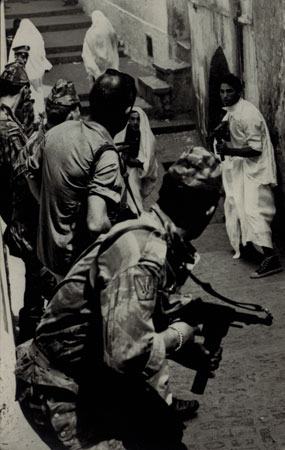
Gillo Pontecorvo, Still from “The Battle of Algiers,” 1966.
DVD NTSC, 121 min. Courtesy of Casbah Entertainment Inc., Los Angeles.
PAUL-ANDERS SIMMA
Born 1959 in Karesuando, Sweden. Lives and works in Norway, Sweden, and Finland.
Paul-Anders Simma is a Sámi filmmaker, who grew up in a nomad family. He is educated at the Swedish Film Institute and has worked with TV production since the mid-1980s. All his films have a close connection with Sámi culture. His breakthrough short film, “Let’s Dance!” (1991), is a humorous story about a Sámi boy going to his first dance. Simma's feature films include: “The Minister of State” (1997) and “The Legacy of the Tundra” (1995), which explores the psychological dimensions of reindeer herding Sámi. His documentary work includes the celebrated “Give Us Our Skeletons!” (1999), on Sámi activist Nils Somby and his quest for the repatriation of the human remains of Sámi ancestors.
Paul-Anders Simma participates in the film program with the film “Give Us Our Skeletons!” from 1999. Locked up in the Anatomical Institute in Oslo, Norway, two skeletons are all that is left of Mons Somby and Aslak Hetta, two Sámi (Lapp) men who were hanged for murder in 1854. The researchers at the institute use the skeletons in their experiments. The descendants and relatives of Mons Somby and Aslak Hetta want them back so that they can give them a decent burial. The question is: Are they simple criminals or national heroes? In this documentary, the main character is Niillas Somby, a descendant of Mons Somby, who leads the battle to have the skeletons returned. The relatives feel that, after more than 140 years, it is time the Sámi heroes were allowed to rest in peace in Sámi country. However, the Anatomical Institute is not likely to release what they consider their property – after all, the men were executed at the cost of the state and therefore belong to the state. The film touches a controversial question in the history of the Nordic countries. Scandinavian scientists were playing a leading role in the development of the “science” that led to the Holocaust during World War II. The main part of the film tells the story of a small people – the Lapps – who still today are battling against the legacy of this racist ideology. [Paul-Anders Simma]
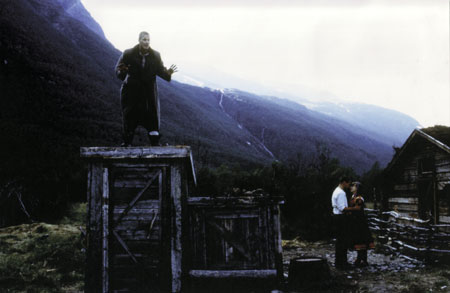
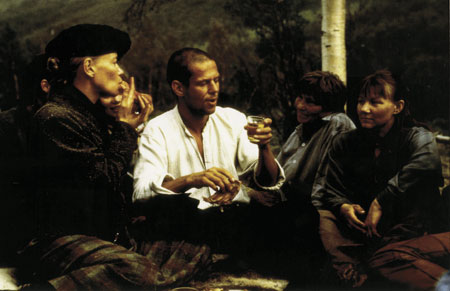
Paul-Anders Simma, Stills from “The Minister of State,” 1997.
Color, 83 min. Courtesy of the Finnish Film Foundation.
